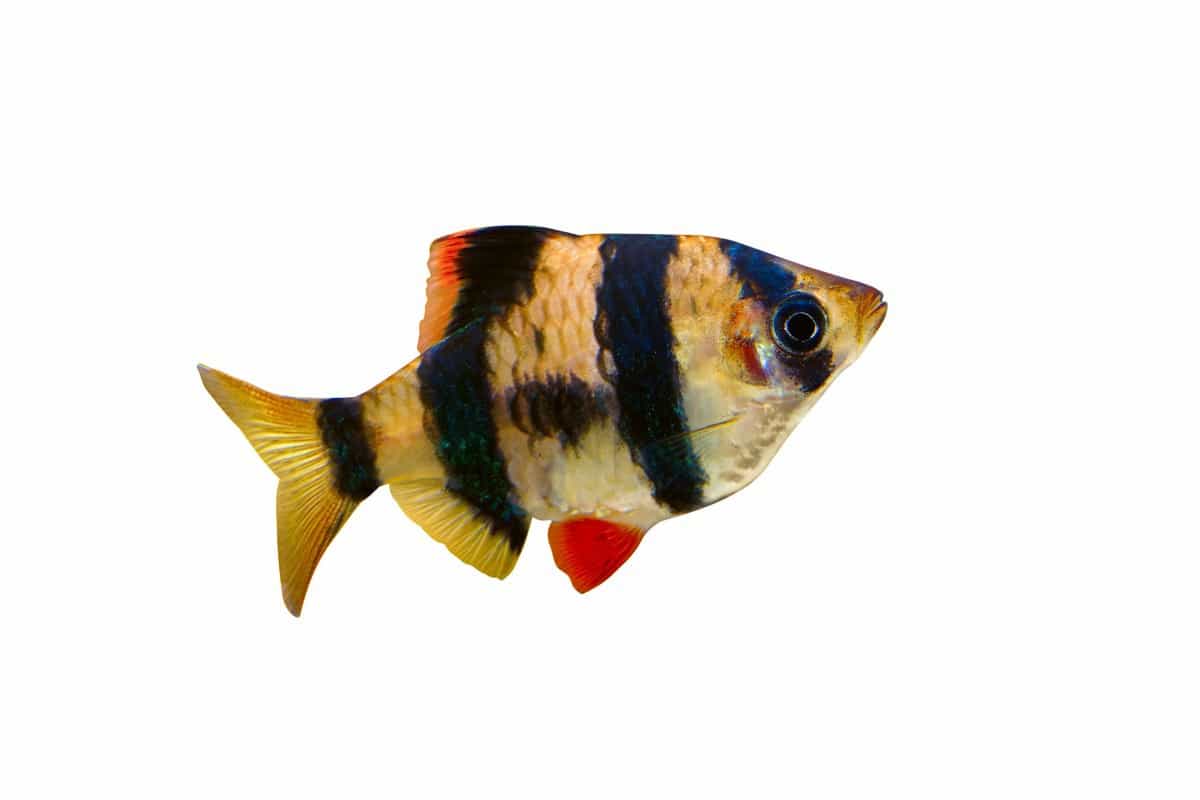
Tiger Barb fish are one of the most popular and sought after aquarium fish in the world today. Through selective breeding, Tiger Barb fish species now come in a variety of colors. Tiger Barbs have even been successfully modified to become Glofish. Glofish emit a fluorescent glow even under normal or UV lights.
Most Tiger Barbs are good eaters and readily accept most commercial dry flake foods or freeze-dried foods; which is another attribute to consider when deciding whether or not you would want a Tiger Barb for your aquarium.
Tiger Barbs provide a lot of movement and color to any aquarium, which is why it is no wonder they have become so popular among beginner and expert aquarist alike.

Table of Contents
Species Profile
| Scientific Name | Puntius tetrazona |
|---|---|
| Common Varieties | Green tiger barb, Tiger Barb, Longfin Tiger Bard, Albino |
| Origin | Mostly farm raised |
| Size | 3" Max |
| Lifespan | 5-6 Years on average |
| Diet | Omnivores |
| Foods & Feeding | 2-3 Times a day. Balanced diet. Flakes, Mini Pellets, Live foods, Freeze Dried bloodwords and shrimps |
| Temperament | Semi-Aggressive |
| Size of aquarium | 20-30 Gallon+ |
| Water Conditions | 74-82° F, KH 4-10, pH 6.0-7.0 |
| Care level | Easy |
| Tank level | Mid to top |
| Color | Orange, White, Yellow, Black |
| Jumpers | No |
| Ideal First fish | Yes |
| Aquarium Decor | Plants, fine gravel, rocks, some shaded areas |
| Cost | $5 |
Types of Tiger Barb Fish
The Tiger barb is one of over 70 species of barb within the aquatic trade. Below, is a list of the most common Tiger barbs which you can find for sale are listed below. Most have been farm-bred and will not be found naturally in the wild. Only the species Puntigrus tetrazona live in the wild.
- Albino Barb
- Longfin Barb
- Tiger Barb
- Glo-Barb
- Green Barb
Tiger Barb tank size
First things first, you need to have an aquarium ready that is of the appropriate size to house at least six Tiger Barbs. This is the minimum at which Tiger Barb’s seems to have the least amount of stress. They enjoy being in a small group and do not thrive on their own.
We recommend a twenty-gallon tank, as this is typically the minimum size for a small group of six Tiger Barbs. The bigger the aquarium, the more they will school and swim around. It really is up to you, the keeper, to decide how big of a tank you want.
How to care for Tiger Barb Fish
A good rule when keeping any fish of any species is to try to replicate their natural environment. The term for this is “husbandry”.
Husbandry describes the whole process of keeping and maintaining your Tiger Barbs and their water conditions.
It sums up water quality, lighting, food, water temperature, appropriate plants and substrate, as well as water changes. Maintaining all of these and creating a balance between them is the most ideal way for your fish to thrive.
Temperature for Tiger Barb fish
Tiger Barbs naturally come from tropical waters. A good temperature to keep them is between 68-82 degrees Fahrenheit. Generally speaking, Tiger Barbs really seem to thrive when the water temperature is kept between 77-82 degrees.
They are a very hardy species and can tolerate changes in water quality very well. We recommend that you try to stay within these parameters as closely as possible.

What Type of Decoration Is Best for Tiger Barbs?
They live in areas where there are plenty of aquatic caves and dense plants for them to hide. We suggest the use of plants or decorations that can double as a safe place for your Tiger Barbs. These provide safe places to escape the hustle and bustle of a busy household.
If you’d like something a bit different for decoration in your aquarium, we recommend reading our article on the Best Fish Tank Ornaments.
What Type of Substrate should I Use in My Tank?
A shallow substrate will do which will make cleaning easier during water changes. Typically enough substrate to hold plants or decorations in place. Tiger Barbs are not diggers so the substrate is purely for decoration only.
What Filtration System Should Be Used With Tiger Barbs?
Depending on the size of the tank and the amount of fish in it, there are several options for water filtration units. The more efficient the filtration – typically the fewer water changes you will need to do. This depends again on the amount of fish in the tank.
We suggest using one of the three most popular filters on sale throughout the aquatic trade.
Read our complete filter guide for the aquarium sizes listed below.
- Best filters for a 10 Gallon aquarium
- Best filters for a 20 gallon aquarium
- Best filters for larger aquariums
How Often Do I Need To Do Water Changes?
It is best to do water changes bi-weekly. Usually about 10-25% per change depending on how well the filtration unit keeps the water clean. Learn how to complete a partial water change in one of our helpful articles.
Lighting?
Tiger Barbs do not need special lighting and an aquarium daylight bulb will be enough. However, their natural environment is shallow waters that are full of vegetation. Recreate this type of environment as much as possible.
Most Tiger Barbs are farm-bred these days and are accustomed to aquarium lights.
Diet?
Tiger Barbs are usually very good eaters. This is one of the things that has made them so popular to keep in home aquariums. They readily accept most commercial flake and freeze-dried foods.
However, you should also offer live food such as bloodworms to supplement their nutritional needs. Furthermore, it is a good exercise for them to hunt their food.
Fish-food manufacturers create their food for specific species. Always read the label to make sure you are feeding foods that are designed to provide all the Tiger Barbs nutritional needs.
We like the three in one fish food from Tetra. It contains flakes, granules and Pellets. This will suit all different sizes of fish in your aquarium. We purchase ours online from Chewy.com click the link for the latest prices.
For a complete feeding guide read our article ‘ What do Tiger Barbs eat ‘ It has all the information you’ll need to ensure your tiger barbs have a well-balanced diet.
| Tiger barb Foods | How Often | How Much |
|---|---|---|
| Flake Food | 2-3 Time a day | Enough that they can consume in under 2 Minutes |
| Mini Pellets | Every 2 days | Small Pinch |
| Bloodworms Freeze Dried | 2-3 Time a week | Small Pinch |
| Live Brine Shrimp | Twice a week | Half a bag in a full community aquarium |
| Live Daphnia | Once a week | Half a bag |
| Freeze Dried Mysis Shrimp | Twice a week | Small Pinch |
| Veggie Pellets | Twice a week | One tablet or strip per feed. |
Size?
The average size for a fully mature, adult Tiger Barb is about 3 inches. Usually, in an aquarium setting, they don’t reach maximum size but since they stay in groups, they are big enough to need plenty of space to move around.
What are Tiger Barb characteristics?
Females tend to have rounder bellies and are typically bigger than males. Both sexes have a broad black dorsal fin with a red stripe just before the tip which breaks up the black at the end. There is not really a great way to tell the sexes apart other than the males tend to be brighter and richer in color and the females are bigger.

They do come in different colors like silver, green, and albino (which is more of a pale yellow color), with faint vertical stripes. They are among a special group of fish that have been genetically modified and are known as Glofish.
What is the Lifespan of the Tiger Barb
The average lifespan of a Tiger Barb is about 5-6 years. Some do live longer with excellent husbandry but 5 years seems to be the average maximum.
Most aquarium Barbs will live longer than their cousins in the wild as they do not have the dangers of predators, weather changes, and food scarcity to contend with.
Tiger Barbs Tank Mates?
Sure! Tiger Barbs are in the category of semi-aggressive – so slow moving fish like Betta’s or Goldfish should be avoided. Furthermore, Tiger Barbs tend to get nippy and may damage the fins of these decorative fish.
Faster, more aggressive species such as Loaches, Danios, Plecos and almost all catfish species are great tankmates for Tiger Barbs, which all add their own special character to your tank.
Also, just about all of these species can be found in the same kind of environment, so food and tank requirements are also the same. This makes it much easier to keep tank parameters where all species will thrive.
They also do very well in large groups of their own species and we recommend that you keep at least six of them at any one time. But more than six is absolutely encouraged.
Here’s a great article for more tank mate suggestions: 21 Examples of Popular Freshwater Fish
Can Tiger Barbs be bred in a home aquarium?
Yes, many Tiger Barb keepers breed their own fish with quite a bit of success. It is because of these aquarists that we have the variety in the colors we see in the green and albino Tiger Barbs today.
There are some special requirements that will need to be set up. A separate breeding tank and a smaller tank with a sponge filter. A sponge filter ensures that adult Tiger Barbs do not eat the fry and protects them from the suction of the filtration system. But breeding Tiger Barbs at home can be a wonderful experience.
Before you start breeding, just realize that Tiger Barbs are prolific breeders with the female laying typically 200-300 eggs and up to around 500 for more mature adults. That is a lot of babies and without the careful watch, their numbers can get out of control.
How should a Breeding tank be set up?
You will need to set up a smaller aquarium for breeding fish. It should utilize a sponge filter which doesn’t cause a lot of water disturbance. Breeding tanks tend to be dimly lit so the fries are not overwhelmed by bright lights.
We encourage you not to use substrate and just leave the eggs to lay on the bottom of the tank as it will be easier to clean later. A daily 10% water change is best, if not, at least every other day.
Tiger Barb breeding habits
Tiger Barbs become sexually mature around 6-7 weeks of age. By this time the females are ready to lay eggs and the males are able to fertilize them.
Often when Tiger Barbs mate, you may begin to notice the group start to pair off. Hence the reason for at least six. The barbs will then start to do what looks like a slow waltz around each other. What is actually happening is that the female is laying her eggs as the male quickly hovers above them to fertilize them.
If you are wanting to breed, we strongly suggest that you move the breeding fish to a special tank used for that purpose. The eggs should never be moved once they have been laid – so it’s better to let it all happen within the controlled tank.
How long before the eggs hatch?
The fertilized eggs will usually hatch within 3-5 days – almost always by day 4. Within a month the juveniles will start to look like the adults exhibiting the unique black vertical stripes and red tips. By 7 weeks old they are mature adults, ready for breeding.
If you have no interest in breeding, then the males will likely eat as many of the eggs as possible – which is normal behavior for Tiger Barbs. You might be surprised at just how many can still survive and may well be shocked to find several more adults in your aquarium.

Wrapping up, Tiger Barb
Tiger Barbs are a wonderful addition to any freshwater aquarium and can add a lot of color and movement to a sometimes dull and boring freshwater environment.
Being a hardy species they eat well and thrive, even when things like water parameters aren’t exactly perfect. Tiger Barbs can be a little aggressive but there are still plenty of fish that get along quite well with them, thus making it easy to add even more diversity to your freshwater paradise.
If this article has made you want to keep Tiger Barbs then you should read our starting a fish tank for beginners. It will help you make the right decisions and set up the perfect tropical fish tank for Tiger Barbs and other species of freshwater fish.
- Comparing Aquarium Gravel To Sand – Which Is Best For Your Tank?
- Marineland Magniflow 360 Canister Filter 360 GPH | Pros and Cons
- Best Aquascaping Tools Every Aquarist Should Use
- Best Aquarium Plant Substrate Review 2022
- Polar Aurora Canister Filter | 2022 Updated Review 525 GPH

I have been working in the tropical fish industry for over 30 years now and I’m still learning. Everyday is a school day in this hobby. In my spare time I play golf very badly!



